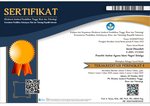Ilusi Kemitraan dalam Wacana Ekonomi Berbagi
Abstract
The emergence of various digital platforms in the era of the internet technology revolution, in addition to giving birth to various new job types, also gives rise to a new term for workers, the term ‘mitra’ in the "gig economy" and gradually replacing previous terms such as buruh, karyawan, pegawai. This article attempts to decode the meaning of "mitra" using Norman Fairclough's critical discourse analysis (CDA) which studies the use of language (verbal and written) as a form of social practice. Through Fairclough's three CDA levels; Text (micro level) is seen as a representation of something containing a certain ideology; Discursive practice (meso level) refers to the production, distribution, and consumption of text; Socio-cultural practice (macro level) refers to the context outside of the text such as the context of society, culture, and politics that influence the existence of text, we can reflect the ideological effects that reproduce unequal power relations in the word "mitra" used by various digital platforms. The term "mitra" referring to the ideology of "platform capitalism" makes them not considered as "pekerja" or "buruh" and eliminating them as legal subjects protected by the Labor Law. The problem is also the new work relationship is still unclear in many aspects, which can lead to exploitation of "mitra" by the company.
Keywords: critical discourse analysis, ilusi kemitraan, gig economy, platform capitalism.
Keywords
Full Text:
PDFReferences
Fairclough, N. (2010). Critical Discourse Analysis: The Critical Study of Language. London: Routledge
Fuchs, C. dan S. Sevignani (2013). What Is Digital Labour? What Is Digital Work? What’s their Difference? And Why Do These Questions Matter for Understanding Social Media?. Communication, Capitalism & Critique 11(2): 237-293.
Isyhadilfath, M. (2019). Perlindungan Hukum bagi Mitra (Driver) dalam Perjanjian Kerjasama Kemitraan Antara Perusahaan Penyedia Aplikasi (Go-Jek) dengan Mitra (Driver). Skripsi: Universitas Sebelas Maret.
Izzati, F. F., (2021). Kerentanan Pekerja Transportasi Daring. Jurnal Prisma. 40(2): 52-63.
Izzati, F. F., Apinino, R., (2021) Ekonomi Gig, Pandemi COVID-19, dan Pekerja Industri Kreatif di Indonesia. Dalam Yeremias T. Keban, Ari Hernawan, dan Arif Novianto (eds.), Menyoal Kerja Layak dan Adil dalam Ekonomi Gig di Indonesia. Yogyakarta: IGA Press.
Izzati, F. F., Larasati, R. S., Laksana, B. K., Apinino, R., & Azali, K. (2021). Pekerja Industri Kreatif Indonesia: Fleksploitation, Kerentanan, dan Sulitnya Berserikat. Jakarta, Indonesia: Serikat Pekerja Media dan Industri Kreatif untuk Demokrasi x FNV Mondiaal.
Juliawan H. B., dkk (2019). Buruh Digital: Peluang Keuntungan dan Intaian Kerentanan. Yogyakarta: Sanata Dharma University Press.
Novianto, A., Keban, Y. T., & Hernawan, A. (2021). Mendorong Kerja Layak & Adil bagi Pekerja Gig: Kajian Awal tentang Ekonomi Gig di Indonesia. Dalam Yeremias T. Keban, Ari Hernawan, dan Arif Novianto (eds.), Menyoal Kerja Layak dan Adil dalam Ekonomi Gig di Indonesia. Yogyakarta: IGA Press.
Srnicek, N. (2016). Platform Capitalism. Cambridge, UK: Polity.
Lora, V. (2018). “Tinjauan Hukum Terhadap Perjanjian Kemitraan Antara PT Gojek Indonesia Cabang Medan Dengan Driver Gojek”. Vivian Lora, 1-110.
Internet
DetikNews. (2019). “Jokowi: Selamat Go-Jek Jadi Decacorn Pertama di Indonesia”. Tersedia di https://news.detik.com/berita/d-4506966/jokowi-selamat-go-jek-jadi-decacorn-pertama-di-indonesia. Diunggah 11 April 2019. Diakses 22 Juni 2022.
BPS. (2019). “Jumlah Perusahaan dan Tenaga Kerja Menurut Klasifikasi Industri di Provinsi Jawa Tengah, 2015-2016”. Tersedia di https://jateng.bps.go.id/statictable/2018/01/24/1685/jumlah-perusahaan-. Diunggah 16 September 2019. Diakses 22 Juni 2022.
Kompas. (2020). “Satu Dekade Beroperasi, Gojek Punya 2 Juta Mitra Pengemudi di Asia Tenggara”. Tersedia di https://tekno.kompas.com/read/2020/11/12/18090947/satu-dekade-beroperasi-gojek-punya-2-juta-mitra-pengemudi-di-asia-tenggara?page=allUU no. 13/2003 . Diunggah 12 November 2020. Diakses 22 Juni 2022.
DOI: https://doi.org/10.18326/dinamika.v4i1.1-12
Refbacks
- There are currently no refbacks.
Copyright (c) 2023 Hasan Labiqul Aqil

This work is licensed under a Creative Commons Attribution-ShareAlike 4.0 International License.








